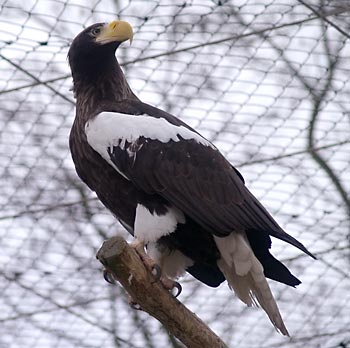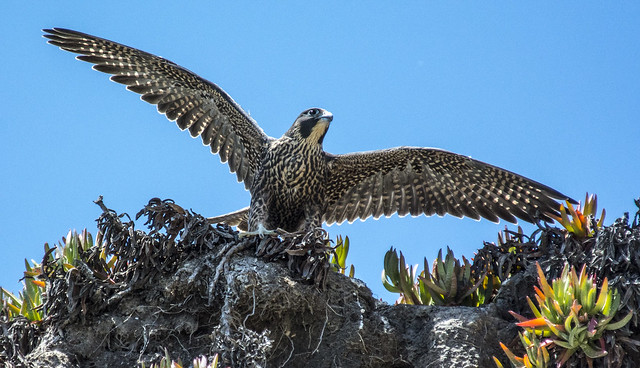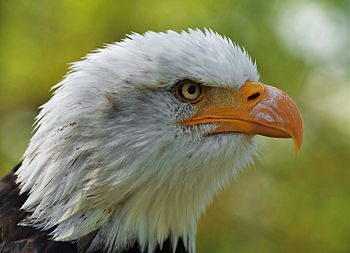 |
| American Bald Eagle taken at the Hoogle Zoo in UT (Photo credit: Wikipedia) |
Of the 'sea eagle' species, the bald eagle is the only one that is native to North America. The bald eagle is immediately obvious by its smooth, white head and white tail, contrasted by the deep brown feathers of its body. Coins, flags, buildings, and seals in the United States have used the image of the bald eagle to symbolize the country.
The bald eagle is a fierce bird of prey, along with other raptors, such as hawks, vultures, owls, and falcons. The bald eagle lives on a diet of live prey, such as waterfowl and fish, as well as rodents, snakes, rabbits, and birds, but they will eat carrion when there is no live prey to be eaten.
Bald eagles are enormous and intimidating birds, with adults growing to 32 inches in length, with wingspans to 7 ½ feet, and weighing up to 16 pounds.
The largest eagles live in Alaska, and the smaller eagles can be found in Florida. Wherever the bald eagle lives, the animals in the region scatter when the bird begins to land.
Each hunting pair of bald eagles requires an area of 2 to 15 square miles in which to hunt. Each pair of bald eagles shares a nest, furiously guarding it against predators. The bald eagle sometimes chases animals that have made a catch of their own, such as the East Central Florida bald eagles that chase Ospreys along the Indian River Lagoon. The eagle will then get to eat the Osprey's catch, as the Osprey drops its squirming prey to escape the eagle.
Although they are birds of prey, the bald eagle shows a tremendous instinct for family loyalty. The bald eagle stays with its mate for life, though few other birds follow this behavior. Though most birds live a much shorter time, the bald eagle can live for as many as 25 years. They live across North America, from the north, including Canada and Alaska, across the middle expanses of the U.S., and south into the northern part of Mexico.
The bald eagle travels frequently, flying to northern climates to escape hot summers, the birds usually return close to the place where they were hatched in order to begin families of their own. Breeding bald eagles lay one to three eggs in the spring, which hatch about 35 days later. After three months in the nest, the baby bald eagles begin to fly, and a month later fly away from their mother for good. The dangers of hunger, disease, harsh weather and toxic chemicals can all make life hard for baby eagles, but almost 70% manage to adapt and survive for at least a year.
Did you know that to save the species in 1940 the United States Congress passed the Bald Eagle Protection Act? This law made it illegal for people to disturb or bother the birds. This also included taking bald eagles for reasons such as selling, trading, or transporting them and also included their eggs and nests. Taking an eagle included shooting at the birds, wounding them, trapping, capturing, disturbing them, or killing them in any manner.
Large numbers of bald eagles died because of DTT, the overuse of pesticides, and other toxic chemicals. The bald eagle was given a chance to be saved by the many reintroduction programs and new laws that were enacted to help them. It seemed nearly impossible to save the species from extinction at the time.
The Endangered Species Act of 1973 allowed species that were small in numbers to be classified as threatened, and species with very low populations to be classified as endangered. In the early 1990s, the rapidly increasing numbers of bald eagles made it possible for the species to be taken off the endangered species lists in most states.
The bald eagle has dramatically increased in numbers between 1963 and 1994, rising from about 500 pairs to almost 5,000 pairs and leading Congress to reclassify its status as threatened. With the increasing population of the bald eagle, the U.S. Fish and Wildlife Service will soon take the bird off the endangered species list.
To observe the bald eagle is a pleasurable experience. The long strides of the bald eagle as it launches leads into the soaring, slow-motion movement of the bird in flight. The determined eagle keeps to its determined path, its prize kept in sight. The skies of North America are increasingly filled with the majestic bald eagle. Everyone should make an effort to see this animal.
|












